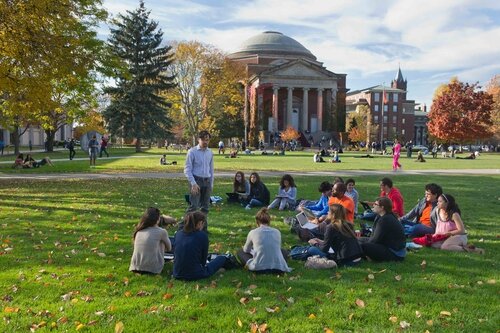The fantasy economics of American higher education

This is a revealing piece (gift link) about the current financial state of American higher ed, through the lens of Syracuse’s struggle to enroll enough students in its entering class. A sort of meta-reveal here is that even somebody who writes books about paying for college seems strikingly naive in some ways about what’s actually going on here.
By the time the usual May 1 college deposit deadline rolled around this year, David Berger’s daughter had already made up her mind: She would leave Alpharetta, Ga., and become a Penn State Nittany Lion.
But Syracuse University, which had also accepted her, wasn’t done with her yet. After having initially offered exactly zero merit aid, its staff began a poaching campaign.
A $20,000-per-year offer arrived on May 2. Then came a $10,000-per-year discount two days later. Weeks went by before Syracuse dangled an additional $20,000 per year.
“Spaces will be filled on a first-come, first-served basis,” that last email said.
All of this left the scores of families that received similar offers scratching their heads. “It’s almost like they’ve turned into used car salesmen,” said Mr. Berger, whose daughter is sticking with Penn State.
Wait a second how much does it cost to go to Syracuse for college anyway?
But the full, nondiscounted cost of attendance at Syracuse stands at $92,128 per year for students who are living on campus and not using the school’s health insurance.
So $370,000 for a four-year degree, assuming no prices increases over that time frame. For Syracuse. The Orangemen. The Carrier Dome. Jim Brown, Pearl Washington, Donovan McNabb, Carmelo Anthony. Good place to go if you’re trying to get into broadcasting. I have now exhausted my knowledge regarding this august institution, and I’ve spent the last 87 or so years in American academia. Oh wait Joe Biden went to the law school.
Anyway is anybody actually paying that?
For snobs inclined to sneer — this is, after all, higher than what M.I.T. charges — the market gets to decide what Syracuse is worth, and 19 percent of its undergraduates in one recent class paid the full price.
One in five. Wut?!? Also, too, note how this essentially mystical entity, the Market, rises up before us, like the transubstantiated Body of Christ, that from what I’ve been told the Orangemen don’t actually believe in. (Is the school mascot actually named after the whole Glorious Revolution thing? Not googling. Also if so this seems like a dubious choice given that I’ve heard there are some Irish Catholics in New York).
So where is this 19% that’s paying the gross national product of Ghana to go to Syracuse coming from anyway?
Meanwhile, just under 20 percent of Syracuse’s undergraduates are from somewhere other than the United States.
Quite a coincidence I suppose that 19% seems an awful lot like “just under 20 percent.”
Has anything happened in the last six months that might make it much more difficult for the Syracuses of the world to depend upon the scions of far distant lands to pay for the salary of the Assistant Vice President for Synergistic Multi-Disciplinary Synergies?
By early May — and certainly by the end of the month — it needed to do something dramatic to change people’s minds. After all, many high school seniors do an Instagram sweatshirt reveal by May 1, a bed party right after with hundreds of dollars of swag from the chosen institution and a simultaneous scramble on Instagram and Snapchat to find a roommate before all the good people are paired off.
Once all that’s done, switching schools requires a pretty big leap.
To Walt Counsell, a 17-year-old high school senior who is set to attend the University of Maryland even after Syracuse threw another $140,000 his way after May 1, Syracuse’s tactics were a bit weird.
By the time Syracuse was done, it had offered him a SUccess award, an Orange award, a Personal Distinction Award and a Chancellor’s Scholarship. (Who names these things, anyway? Syracuse’s chancellor, Kent Syverud, and several members of his staff did not respond to requests for comment on the money that the school gives out in his name. )
Ah Kent Syverud! We were graduate students at Michigan together in 1983 . . . then he was a professor at the law school when I was a student there . . . Then he got into the administrative rackets and look at him now, no commenting in the New York Times when the green eye shade comes out. I wonder what he’s pulling down?
Form 990 says . . . $1,157,881 in “reportable compensation,” and $468,032 in “other compensation.” I’m in the wrong business, as my wife likes to say when she gazes at a $10,000 lamp at Design Within Reach. (Actual price; also actual name of the store, in case you think I’m making any of this stuff up).
The framing of this story by the Times illustrates just how distorted the thinking about the economics of higher ed are in this country. The idea that Syracuse is offering to “give” some kid from Marietta GA $200,000 to attend via “merit scholarships” with made up on the spot fancy sounding names is just a bit jejune, to use a word you might learn in college. This is like, to return to that car metaphor up top, saying said dealer is “giving” me $5,000 if he’s willing to knock that much off the MSRP of the tan Ciera I’ve had my eye on (they add that Tru-Coat at the factory you know).
There’s a lot more to say about exactly where all this is heading, but that’s for another post. For now let’s check in with Chancellor Lundegaard:


